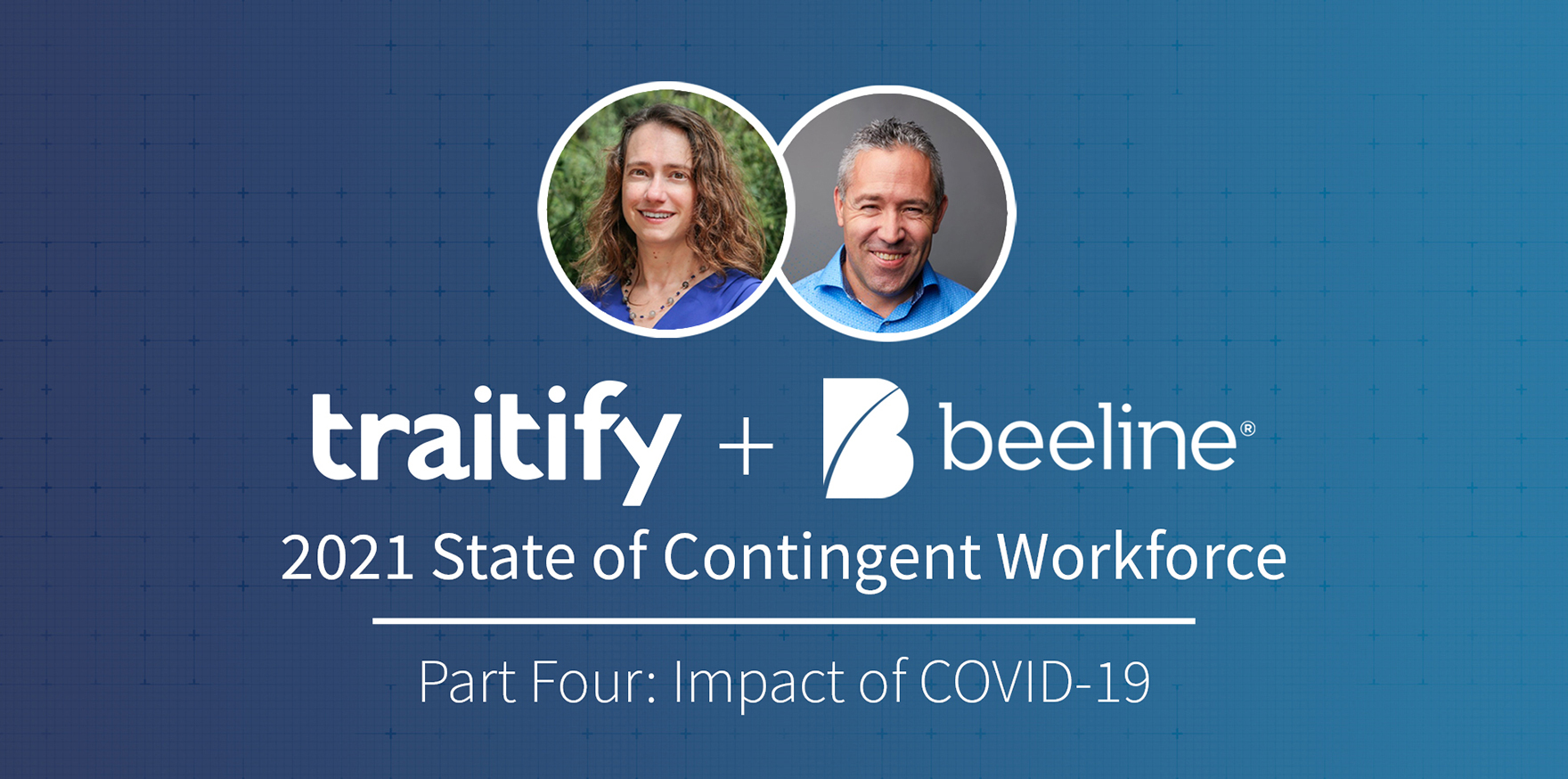Making Vaccines. Remote Work. Diversity, equity, and inclusion. How has the pandemic affected the contingent workforce in these areas — and vice versa? Brian Hoffmeyer of Beeline discusses with Dr. Heather Myers in the penultimate part of our video series.
ICYMI, here is the 3rd part of the series on the current state of the contingent workforce.
Continue to the final part of the series on automation and the impact on talent acquisition here.
The full series is also on YouTube here.
Transcript:
HEATHER: Obviously, our world has changed so much—right—recently, through the global pandemic, and I’m curious as to how this has impacted the industries that you see. Because clearly it’s impacted different Industries in different ways.
BRIAN: If there’s a silver lining of the global pandemic—I mean actually, I think there’s a number, because it’s been remarkable to see how the world and humans have come together to innovate on things like vaccines.
HEATHER: Absolutely.
BRIAN: But companies have realized that they need to know who their contingent workers are. You know, are they safe? Are they healthy? Can they work remotely? So we saw a big uptick in companies sort of asking those questions, and realizing they need to get their hands — to my earlier point about one of the common pain points — around this contingent workforce. And then they had to start answering questions about things like remote work, because typically, even if an organization allowed their employees to work remotely, contractors weren’t, right? And so at the start of the pandemic there was this shift of like, “Oh my god, what do we do? How do we get them the equipment?” And all these kinds of things, right?
HEATHER: Right.
BRIAN: Two probably interesting examples. One is life sciences. You know a lot of our Pharmaceutical clients had to very quickly staff up to literally do things like develop vaccines. You know, we have one of the vaccine makers as one of our clients and they were using—
HEATHER: Oh wow.
BRIAN: They were using scientists who were contractors who developed that vaccine. And so they had to staff up very quickly, not just the scientists themselves, but all the support, you know, around that—
HEATHER: Yeah.
BRIAN: —their IT needs, for example. And then another good one is what we broadly would call “high-volume staffing,” right? So you think about retailers of all types that have big online presences. We all know that their volumes skyrocketed during the pandemic and maintain at high levels, And so they needed workers very quickly, and a great way to do that is via non-employees, but they’re also faced with a lot of challenges in that — especially at the lower end of the pay rate, the covid-related benefits at times were higher than what they could afford to pay. And how to make those decisions, and of course you can't work in a distribution center remotely, and so where do you find your workers, and how do you keep them safe? And just tracking and knowing who they are, via a system like ours, is important. As well as, even in lower-end kinds of roles—you know—making sure that the person is fit for the job is still an important part of the thing. You know, different organizations have different ways of working, different cultures, etcetera.
HEATHER: Yeah, no absolutely, absolutely. So how do you think—you know—are there any other ways in which the contingent workforce has played a role to kind of solve some of these problems, that you haven't already mentioned?
BRIAN: You know, what companies have realized, and this applies to both their full-time workforce and their extended workforce, they don’t necessarily have to hire them in the place where they're located. right?
HEATHER: Yeah.
BRIAN: And so it's opened up options. So you know my company’s based in the Bay area, you know, high cost of living, commensurate high salary—I know you’re based in the Bay Area—
HEATHER: Oh, that’s—yep!
BRIAN: But you know, if I can find the same skill set in—I always use Des Moines, Iowa as my—I don’t know if Des Moines, Iowa is that inexpensive to live in or not, but it seems to fit.
HEATHER: Yeah.
BRIAN: If I can bring people in there, and they're just as effective, great! I can save money and get the same quality, but then that creates these other problems. How do I manage them? How do I know somebody that I've never met before is going to work out? Not only from: Can they code Java? But what is their personality type? And, you know, that's one of the ways that we love what Traitify does. It really helps in this environment where you're hiring people you've never met before, never met in person, to know: What are their characteristics? What are their strengths and how do they compliment my team? How do they fit with my management style? And one of the great things about that, too, is it’s great not only for the company, but for the worker themselves, because it lets them know, “Oh, I might not be the best fit here.”
HEATHER: Right, right, and you know, if it’s not a good fit, it usually won’t work out well for either party. So yeah, that’s for sure.
BRIAN: And the other one that I'd be really—it’d be remiss of me not to mention is diversity, equity, and inclusion. That's become a big part of the contingent workforce, as well. It’s probably the number one thing that we’re talking about with our clients. How do they ensure diversity, equity, and inclusion in their contingent workforce? The big shift we see is that it used to be that companies felt like they had diversity as long as their suppliers were owned by diverse individuals.
HEATHER: Oh, interesting.
BRIAN: Diversity ownership is not an equal and diverse workforce, because if you’ve got a diverse slate of suppliers, if they send you people that are all the same, you're not diverse.
HEATHER: Right.
BRIAN: It’s that big realization that companies have also realized that — across the board, again, DE&I is incredibly important — and they can make a very quick change in the diversity of their workforce by increasing the diversity of their contingent workforce, because by its very nature it’s temporary, right? It turns over, and so even if you're—let’s say you’re a 10,000-person company and 20% of your workforce is non-employee. That’s 2,000 people. It’s not very diverse today, but your average length of those assignments is three months. In three months, those 2,000 people could be much more diverse. And so, figuring out strategies to attract diversity, and make them be included and be part of your workforce—a true part of your workforce is a big topic today.
HEATHER: Yeah, absolutely. Absolutely.
BRIAN: And again, you know, that’s another great way that Traitify comes in. Because Traitify helps with diversity of strengths and thoughts and personality. That’s, to me, a very much a part of diversity, as well. Because if everyone thinks and acts the same, not great either.
HEATHER: Yeah, right. You don't necessarily want a team that’s comprised of all the same people with the same personality characteristics, because then you'll have a zillion people with great ideas and nobody to actually follow through and get it done, right? Or vice versa. So yeah, for sure.
Contact:
Heather Myers, Ph.D. - heather@traitify.com, Heather Myers, Ph.D.
Brian Hoffmeyer - hoff@beeline.com, Brian Hoffmeyer, homechefhoff
To learn how Traitify can help you attract, select, and engage contingent workers, connect with us!





